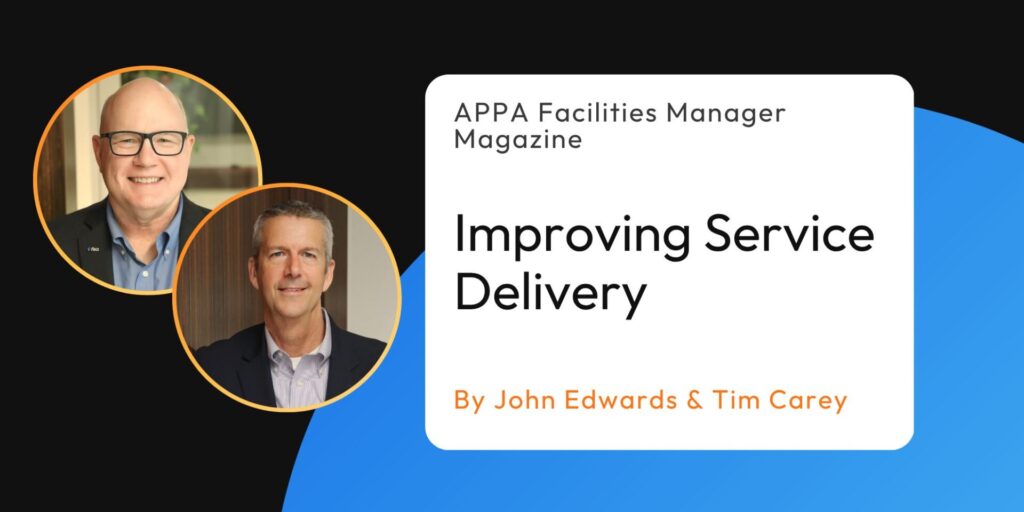Aligning Service and Expectations: Using Service Level Agreements to Improve Service Delivery
Reflecting on “Improving Service Delivery Through Facilities Alignment and Service Level Agreements” by John Edwards and Timothy Carey
Facilities leaders across higher education are facing a familiar set of challenges — tightening budgets, rising customer expectations, and ongoing workforce shortages. In their Facilities Manager article, published by APPA, John Edwards and Tim Carey highlight a practical, proactive approach to tackling these realities: using Service Level Agreements (SLAs) to align facility service delivery with institutional priorities and available resources.
From Frustration to Clarity
As Edwards and Carey note, many facilities managers (FMs) feel caught between what their institutions expect and what their resources allow. It’s easy to blame inadequate funding or a lack of understanding among customers. Yet, as they argue, real progress begins when facilities teams clearly define — and communicate — what services can be delivered, at what level, and with what resources. That’s where SLAs become powerful tools for alignment.
An SLA defines the services provided by the facilities organization, the performance standards for those services, how performance is measured, and the shared responsibilities of both the facilities team and its customers. When well crafted, SLAs establish mutual understanding and accountability — preventing confusion, easing administrative burdens, and improving satisfaction on both sides.
The authors cite an example from the University of Connecticut, where the facilities department implemented an SLA with Residential Life during an organizational merger. The agreement simplified billing, clarified service expectations, and created a model later replicated with other campus units. This kind of transparency not only improves efficiency but also builds trust across departments.
Connecting SLAs to APPA Levels of Service
One of the most valuable insights from Edwards and Carey’s article is the connection between SLAs and APPA’s Levels of Service. These standardized definitions for maintenance, custodial, and grounds care provide a clear, shared vocabulary for service outcomes — ranging from “Orderly Spotlessness” to “Neglect.”
By referencing APPA’s framework, facilities managers can quantify what it takes to move from one level of service to another — in terms of staffing, budget, and resources. For example, if an institution currently delivers Level 3 (Casual Inattention) custodial service but wants to achieve Level 2 (Ordinary Tidiness), APPA’s tools can help estimate the additional full-time equivalents (FTEs) and costs required. This data-driven clarity transforms service conversations from subjective expectations to objective, informed planning.
Creating Shared Responsibility and Continuous Improvement
Edwards and Carey emphasize that SLAs are not one-time agreements; they’re living documents that evolve with organizational needs. The process of creating them should be collaborative — involving both facilities staff and the departments they serve. Effective SLAs, they explain, share several traits:
-
Customer focus: Agreements reflect each department’s unique mission and priorities.
-
Education and transparency: SLAs clarify what can (and can’t) be delivered within existing resources.
-
Documented responsibilities: Both facilities teams and customers have defined roles and expectations.
-
Scenario planning: “What if” clauses address emergencies, weather events, and shifting priorities.
-
Regular review: Annual or semiannual updates keep agreements relevant and aligned.
UConn’s approach — revisiting SLAs each year to adjust for budget changes, salary shifts, and actual service activity — demonstrates the value of maintaining these agreements as adaptable management tools.
Building a Culture of Alignment
Ultimately, Improving Service Delivery Through Facilities Alignment and Service Level Agreements is about more than templates and metrics — it’s about culture. SLAs help transform facilities management from a reactive service provider to a strategic partner. They foster collaboration, improve communication, and ensure that expectations, funding, and outcomes are all moving in the same direction.
In a time when facility leaders face unprecedented pressures — from aging infrastructure to shrinking budgets — clarity and alignment are not luxuries; they’re necessities. As Edwards and Carey remind us, when customers and facility professionals share a common understanding of what’s being delivered, everyone wins.



